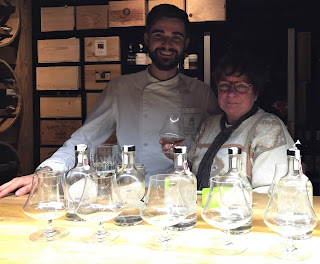In the run-up to the festive season celebrations, many of us
are likely to be exposed to plentiful supplies of alcohol. In the presence of
such temptation and, urged on by friends and colleagues to ‘have another one’,
many of us will be inclined to indulge a little too freely, resulting in a
whopping great hangover.
Personally, whether intentional or not, and despite having
had more than my fair share of hangovers in the past, I find it hard to
understand why anyone would drink in sufficient quantities to make themselves
ill.
With the exception of my 60th birthday (the hangover was a
mistake, honest!), the last time that I was drunk was on Boxing Day 1974. I was
ill for three days and swore that I would never be so again. This is no mean
achievement for someone in the food and wine business, where I frequently taste
up to 20 or 30 wines at a time.
A hangover is your body’s reaction to drinking too much
alcohol, and of course, the best way to avoid a hangover is to limit how much
you drink – easier said than done.
Research is limited, and there is no known cure for a
hangover, because the exact causes are poorly understood. It is thought that
the body experiences specific hormonal and immune responses during a hangover
that trigger different symptoms.
Drink/drive laws have become much tougher in recent years,
and rightly so. The alcohol limit for drivers in England is 80 mg. of alcohol
per 100 ml. of blood. In Scotland, and on the continent, the limit is even more
stringent.
This limit does allow a man of average height and weight to
drink up to four units of alcohol (two pints of normal-strength beer or two
double whiskies) and remain within the law, whilst women can drink three units
(a large glass of average strength wine).
It takes an average adult about one hour to process one unit
of alcohol, but this varies from person to person. Lecture over.
Dehydration is one of the keys reasons for feeling rough
after a night out on the town.
Although dehydration it is not the only cause of a hangover,
it does contribute to symptoms such as increased thirst, fatigue, headache and
dizziness. It is thought that selecting drinks that are low in ‘congeners’ may
also help reduce the incidence and severity of hangovers.
Congeners are substances, other than the desired type of
alcohol (ethanol), produced during fermentation. They include small amounts of
other chemicals that are responsible for much of the taste and aroma of distilled
alcoholic beverages, and also contribute to the taste of non-distilled drinks.
Finally, get plenty of sleep, as excessive alcohol
consumption can cause sleep disturbances and may be associated with decreased
sleep quality and duration.
While a lack of sleep does not cause a hangover, it can make
it worse.
ARTICLE FEATURED IN SOMERSET LIVING - JAN 19




















